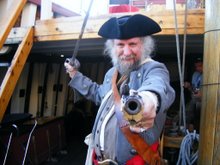A shallop (from the French chaloupe en fagot) was a small boat, larger than a ship's boat. The prow and stern were rounded. The stern was shaped like the bow except for the addition of a rudder and tiller. They could be disassembled into two or more pieces for easy transport. Both the Jamestown and Plymouth colonies had them. John Smith spent months on one mapping the Chesapeake. The one that the Pilgrims had was their chief means of transportation by water for some time. They were mainly coastal vessels. Larger ones might have a deck or half-deck. They were good craft for exploration since they were shallow-drafted and could be sailed or rowed.
These were not ideal pirate boats by any means but pirates tended to make due with whatever was at hand. Morgan probably had a shallop or two with him on some of his raids.
I've been looking at modern examples to study their rigging. They have the same type of sails as my Whitehall boat - a large sprit-rigged sail and a jib.
There are at least five modern shallops. The oldest was designed for Plimoth Plantation by William Baker who designed most of the 17th century reproductions built in the 1950s through the 1970s. There are no paintings or woodcuts that show shallops by name so he had to decide which type of boat to use. He went with a style that is common in Dutch paintings. This had the sprit-rigged sail and lee-boards rather than a keel.
The Pilgrim shallop was built to meet the Mayflower II when it arrived in America in 1957. Baker's plans called for it to be lapstrake (overlapped planks) but the builders refused, insisting that this was a sign of inferior workmanship. I've been on this shallop a couple of times, once for an afternoon sail and once for three days of filming a National Geographic video on John Smith's voyage.
The John Howland Society along with Plimoth Plantation built a larger shallop based on a description from William Bradford's History of Plimoth Plantation. There is an account here including the reasoning behind the design and a description of the launch.
Three other shallops were built for Jamestown's 400th anniversary. You can see them all here and here. (Note that one of these has a wineglass transom.) Here are pictures of one of them being built.
Here is a PDF document with a lot of information on shallops including naming the diffierent parts. Pirates who want to know more about ships should study this. This shallop was designed from the beginning to be broken down into two pieces. Note that each half can float on its own. The halves are kept together with special pieces from the keel and rails.
Here is a archaeological dig of an original late-17th century shallop.
There are numerous images of shallops on Google Image.
Subscribe to:
Post Comments (Atom)


No comments:
Post a Comment